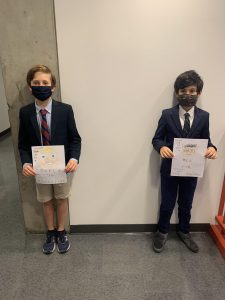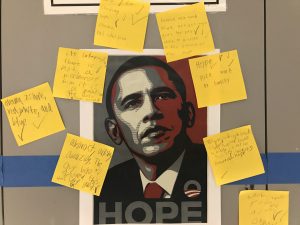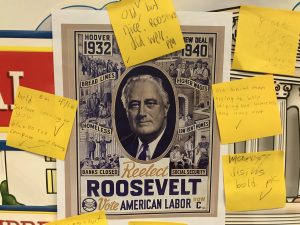
Silver Cluster students were assigned a government position to run for. The class will vote on who they want to win during an election on November 3.
As Election Day approaches, students at Gaynor are learning about presidents, the responsibilities of citizens, and strategies to manage their emotions.
In Early Childhood, students practice their own form of voting on issues that are important in the classroom, such as options for activities.
Classes also discuss Presidents Day beginning in late January and early February. The discussions and activities focus on the historical significance of the presidents we celebrate, as well as presidential responsibilities and an introduction to laws, focusing on laws students are familiar with, such as those surrounding safety.
Early Childhood Director Rebecca Jurow said teachings leading up to this year’s election have changed a bit given the current circumstances.
“This election year is different from previous elections in so many ways, and our approach is a little different as a result,” Ms. Jurow said. “Our focus in these fraught times is on the civic responsibility of voting, making your one selection, having your voice heard, and advocacy.”
Silver and Green Cluster students continue to learn about democracy by taking a deeper look into presidential campaigns and elections.
One Silver Cluster class learned last week about the democratic process and the active role we should take in our democracy as citizens. Students then switched roles from voters to officials running for office. Each student was assigned a government position to run for and will have to write a campaign speech, which they will present to the class to gain voters. The project will finish on November 3 when they have their class elections.
In the Green Cluster, one class analyzed political campaign posters. Students had a gallery walk of some iconic posters through the years. After reflecting on the images, they posted their reactions and observations of designs, symbols, and artists’ intent with sticky notes, and then responded to their classmates’ observations.
In the Blue Cluster, students learn about what a democracy is, what it means to be a citizen, and the rights and responsibilities of a citizen.
Students also learn about the spread of fake news and how to evaluate a source to determine if it is reliable.
Upper Division Director Christine Karamanoglou said, “This is essential because as information has moved to online sources, it is important for our students, especially, to know that these are not all reliable sources. In addition, it is also important for them to know that despite what is being said in the political world, mainstream news is not fake news, but all news sources have a bias. Their job is to be able to recognize both, and there are specific ways to look for that information.”
An election can bring out many different emotions in people and can be a stressful time given all of the unknowns.
Children are also sensitive to the powerful emotions that surround an election, and Gaynor’s Psychology Department is working to make sure students have the resources they need to cope.
The team created guidelines and shared tools with teachers to help with classroom discussions about the election, and to provide a safe space for students to have these discussions. They also utilized RULER techniques, such as the Mood Meter and Blueprint, which provide strategies for empathy and conflict resolution.
Director of Psychology Clare Cosentino said they are having these conversations before the election so on the days following, teachers can remind students of these conversations, how to have respect and empathy, and how to regulate their emotions.
“We want to empower kids to communicate and create a classroom environment where all voices can be heard,” she said. “We want to teach them empathy and perspective taking. This really takes us back to the values of our school. We want to create a space where students can respect one another, even if they have a difference of opinion.”


